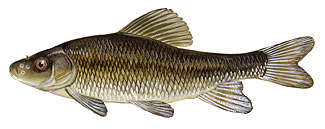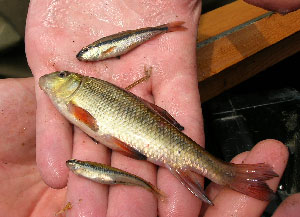Creek Chubsucker
Erimyzon oblongus
 Distribution: Creek chubsuckers are found along the Atlantic slope drainages from southern Maine south to Georgia. They are also present in watersheds draining into Lake Ontario, in New York. In New Hampshire they are relatively common south of the White Mountains.
Distribution: Creek chubsuckers are found along the Atlantic slope drainages from southern Maine south to Georgia. They are also present in watersheds draining into Lake Ontario, in New York. In New Hampshire they are relatively common south of the White Mountains.
Description: Adult creek chubsuckers are golden in color, with pleated sucker-like lips, large prominent scales, and no lateral line. Creek chubsuckers are more oblong and laterally compressed than the cylindrical body shape of common white suckers. Juvenile creek chubsuckers have a dark lateral band which makes them easy to confuse with bridle shiners.
Species commonly confused with: Bridle shiners, white suckers
Habitat: Creek chubsuckers are found in slow flowing rivers and streams with muddy bottoms and aquatic vegetation.

Life History: Creek chubsuckers feed on a variety of invertebrates found on the bottom and among aquatic plants. Like the white sucker, the creek chubsucker spawns over gravel bottom in swift current. Creek chubsuckers are considered moderately pollution tolerant, but intolerant of habitat disturbance. As more visual foragers than common white suckers, they may be more sensitive to turbidity.
Origin: Native
Conservation/Management: Juvenile Creek chubsuckers are frequently observed feeding in small schools during surveys for bridle shiners, which are a state threatened species. Both species are usually associated with healthy stands of submerged aquatic vegetation. Protecting riparian buffers around small ponds and low gradient wetland streams will benefit creek chubsuckers.



